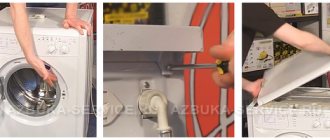Any household appliance, even the most reliable, breaks down over time. And many owners do not know, for example, how to disassemble a Tefal iron with their own hands in order to find out and eliminate the cause of the breakdown. But in most cases, you can repair electric irons of this brand yourself, without resorting to the services of service centers.
One of the Tefal smart irons, Ultimate Autoclean 300 series
In the article, readers will find information on how to disassemble Tefal electric irons of popular models, as well as common defects and ways to eliminate them.
DIY iron repair
Most often, iron repairs are done by yourself.
To do this, you need to prepare tools: screwdrivers and a tester with a light bulb. Important! Even if you only need to repair the cord, the iron will have to be disassembled. Irons from different manufacturers may have different designs, but there are always common points:
Irons from different manufacturers may have different designs, but there are always common points:
- To fasten the sole and body, not only latches are used, but also screws that will have to be carefully searched. They are often placed under decorative caps, a water tank or other elements.
- If the indicator lights do not light up when you turn on the device, then most likely the problem is in the cord.
Armed with such information, you will definitely cope with the task of how to disassemble a Tefal iron.
Repairing the cord
In 20 percent of cases, the breakdown is due to a non-functional cord. To check it you need to do the following:
- Remove the back cover of the iron.
- We check the voltage with a tester.
- If the tester light does not light up, the cord is shortened and checked again.
Important! If the light comes on, the problem is not in the cord and you need to disassemble the Tefal iron further
Repairing the thermal fuse:
- In this case, repairing the iron begins with disconnecting it from the network.
- Then wires are connected to the thermal fuse on both sides for continuity.
If the light bulb does not light up, then the fuse is faulty. You can take it out and short-circuit the electrical network in this part.
Important! In this case, there is no need to worry, because if the thermostat is working correctly, the missing fuse will not cause problems
Repairing the temperature controller
Before disassembling the Tefal iron, you need to try removing the external regulator handle. To do this you need to slightly pry it. If the attempt is unsuccessful, the screws are unscrewed and the housing is removed.
To check the functionality:
- The regulator is set to its extreme positions. If this cannot be done easily, you should use pliers.
- The electrical network rings and at the same time the regulator turns.
Important! If the light comes on in the extreme positions, then there is no breakdown in the thermostat, but if not, the contacts will need to be cleaned. To do this, use sandpaper or an ordinary nail file.
Repairing the heating element
If all the main components are checked, then the repair of the Tefal iron is not completed. Most likely the problem is a faulty heating element. Even if you know how to disassemble a Brown iron, it will not help. Replacing the heating element is almost impossible - in almost all cases the device will have to be thrown away.
Important! Even if you throw away your old iron, keep the cord. It will be useful for repairing other household appliances
Repairing the steaming system
To avoid problems, you need to use distilled, filtered or boiled water. Most often, when repairing a steaming system, scale must be removed. For this process you do not need to know how to disassemble a Philips, Tefal or Brown iron. You will act as follows:
- To clean the iron, place it in a large container of water. The water level should be one and a half centimeters above the sole.
- The steam regulator should be set to the maximum value. The back of the appliance should be slightly raised using stands.
Important! It is strictly forbidden to plug in the iron during descaling.
- Add vinegar to the water (1 glass per liter of water).
- Place the container on the stove and wait until the water boils.
- After cooling slightly, put the container on the fire again. We repeat the procedure two to four times.
Important! Vinegar can be replaced with citric acid or a special descaling agent.
Temperature controller malfunction
Another key element of Tefal irons is the temperature regulator. In order to simplify access to the regulator, first of all, you should try to remove its handle from the outside of the case. If this cannot be done, you will have to completely disassemble the case and unscrew the fastening elements to access the desired part of the device.
Diagnostics of the regulator is performed in several stages:
- Set the regulator to its extreme positions; if this is impossible, use pliers;
- Ring the element using a tester, periodically switching the regulator to different positions;
- If the tester light is on in the extreme positions of the regulator, the element is working.
In cases where there is a malfunction of the element, you will need to clean the contacts. To do this, it is recommended to use sandpaper, a nail file or a similar abrasive product. After cleaning, you can wipe the contacts with alcohol and let them dry, which will increase the cleaning efficiency.
This is interesting! Modern technology - steam cabinet for clothes and ironing equipment
Models that should not be repaired yourself
A device that you don’t even have to try to repair with your own hands is the Tefal cordless iron. There are various options for such devices on the market:
- with contact pads;
- with a sole that accumulates heat;
- with detachable power cable.
The first two categories clearly require diagnostics, disassembly and repair using special equipment: it is unlikely that it will be possible to repair such an iron at home. The third category has a clearly defined weak area. The work flow looks like this:
- The iron with a cable connected to a special mechanism is connected to a 220V network.
- When the temperature set by the regulator is reached, the cable is fired by a spring block.
- Until the temperature drops, it is impossible to insert the cable into place: it is not fixed, and in some models it is not even inserted.
The problem with cable shooting irons is the same - they have two thermal control mechanisms: the main one and the cord fixation mechanism. Over time, owners of such a model will have to switch to the following scheme of action: after ironing a piece of clothing, wait for the temperature to drop, insert the cord, move the regulator to a higher value and wait again. The reason for this behavior of the iron is the oxidation of the bimetallic plate of the shooting control device. It is enough to clean it, replace it, and in some cases just fix it.
Chemical descaling agents
Pencil
You can buy a pencil for cleaning your iron at any hardware store. The structure of the product involves removing carbon deposits from the outside of the sole, but the product also helps to clean the steam vents
The only thing you need to know when treating the surface is safety precautions, because cleaning is carried out when the working surface is heated
Fill the iron reservoir with water and heat the device to maximum. Use the working side of the pencil to work on the soles. The product will begin to melt, and the resulting plaque will come off with it. Wait 30 seconds, then gently wipe off any melted residue with an old rag. Run the steam cleaner to clean out the holes with steam, and finish by wiping the soleplate dry.
Despite the ease and simplicity of manipulation, keep in mind that the processing process will be accompanied by the release of an unpleasant odor, which can cause dizziness. To avoid negative consequences, carry out the procedure in a well-ventilated area.
It is not recommended to use aggressive household chemicals if the iron is intended for ironing children's clothes.
"Antinakipin" or analogue
Antiscale is considered the most popular commercial anti-scale product. It will easily dissolve mineral deposits, after which removing them will not be difficult. The product is diluted with clean water, following the instructions, after which the solution is poured into the tank. Next, the device needs to be heated to maximum, unplugged and left for half an hour.
Then the device is strongly heated again, and after cooling, all the liquid is removed along with pieces of plaque. Next, the container must be rinsed under running water, dried and replaced. After the procedure, be sure to test iron the unnecessary piece of fabric.
Topperr (“Topper”)
Topperr is a company that produces various products and chemicals for iron care.
The drug is diluted with water in a ratio of 2:1. Next you need to proceed step by step:
- Pour the solution into a water container.
- Heat the unit while holding it in an upright position.
- Unplug the device from the outlet and place it horizontally on an unnecessary piece of fabric, placing a piece of oilcloth on the ironing board.
- Leave the iron in this position for 2-3 hours.
- Drain the used fluid and fill the reservoir with clean water.
- Warm up the unit, set the steam supply mode and use it to clean the holes in the sole.
(Technology may change over time; follow package instructions.)
Other
Another well-known household chemical product for removing scale from irons is the German drug Optima Plus OP-020. It contains only organic components, so it can be used without fear of damaging the device. If you trust the reviews, the effect of use is noticeable the first time
Before cleaning, read the instructions and follow the precautions described therein.
There are a large number of anti-scale products on the market, such as Magic Power, Bon and others. To descale your ironing device, you can choose any of them or use proven folk remedies. We hope our recommendations will allow you to make the right choice.
According to sole material
Let's determine the best Tefal 2022 iron with a ceramic sole and a metal-ceramic sole.
Ceramic-metal soles of Tefal irons will have different advantages and disadvantages than ceramic ones, so choosing which one is better would be incorrect.
Ceramics
The ceramic sole glides amazingly over the fabric, heats up instantly and is easy to clean. Its disadvantage is extreme fragility. This means that the iron cannot be dropped, otherwise you will have to look for a new one.
Tefal FV2548
pros
- vertical steaming
- powerful steam
- water stone filter and self-cleaning
- adjusting the strength of the steam flow
- drip sprayer
Minuses
- small water container: 270 ml
- no auto shutdown
The model stands out in its category for its high power (2,200 W), as well as steam flow density (35 g/min). The steam boost exceeds 100 g/min, which is more than four atmospheres.
This is a great iron for the home. But there is one thing: the amount of clothes you can iron at one time will be small, since the tank is small, only a glass of water. With such a volume of evaporation, this glass will instantly disappear, and you will have to add more.
Tefal FV5615 Turbo Pro
pros
- you can iron things on a hanger
- abundant steam
- turns off without moving
- water stone filter and self-cleaning
- anti-drop
Minuses
- little water included (300 ml)
- turns off after 30 seconds
An incredible amount of water (200 g/min) evaporated during a burst of steam smooths out wrinkles even on over-dried linen items. Only the boiler is too small for such productivity.
Otherwise, everything is super: protection at the highest level, cleaning of everything and everyone. If the boiler were made larger and the price lower, then the Tefal FV5615 Turbo Pro would take first place in any rating. And so - only number two.
Metal ceramics
Soles with a ceramic layer combine the advantages of both metal and ceramics. Easy glide across the fabric coupled with durability make using these types of irons a pleasure.
Let's try to choose the best Tefal iron with a cermet sole.
Tefal FV4963
pros
- ability to steam hanging items
- powerful steam
- prevention of condensation formation
- lime protection, self-cleaning
Minuses
- little water comes in
- no automatic shutdown
- poor ergonomics
The model became the choice of buyers in 2022, representing the best price-quality ratio. The iron is good, made with high quality. Self-cleaning anti-scale systems leave lime no chance. Powerful steam creates the effect of an air cushion, causing the iron to glide across the fabric on its own. The steam flow is adjusted manually. Thanks to vertical steaming, you can smooth out wrinkles on hanging curtains or refresh your blouse.
But there won't be much water. Divide 270 ml by 40 ml per minute: we get 7 working minutes without a steam boost. When you are ready to iron, place a stock next to it for pouring. In reviews, buyers complain about two things:
- inability to track the level of water being poured;
- inconvenient location of the steam boost button (under the index finger at the bottom of the handle).
Such shortcomings can be easily dealt with by pouring exactly a glass of water into an empty boiler. But the button takes some getting used to.
Features of Tefal cordless irons
Irons fail quite often. Tefal devices are no exception. However, not all irons of this brand can be repaired. You cannot fix a problem with a wireless device that has:
- contact pad;
- heat accumulating sole;
- detachable power cable.
Repair of the Tefal iron of the first two types can only be carried out using special tools after a thorough diagnosis. The device with a detachable cable functions as follows:
- The wire is fixed in a special mechanism.
- The iron is connected to the network.
- When heated to the set temperature, a special spring unit is activated, which disconnects the cable. Until the temperature drops, it will be impossible to insert the wire into place.
The detachable cord wireless device includes a main mechanism and a cord locking mechanism. After a certain time, difficulties may arise when using such an iron due to oxidation of the bimetallic plate of the firing device. They consist in the fact that some time after the start of ironing, you need to wait for the temperature to drop, connect the wire, switch the temperature sensor to a higher value and wait again.
Steaming system and heating element
Everyone knows that the most important element in the design of a Tefal electric iron is the heating element . To diagnose its performance, you can use a tester similar to the previous option. However, the element itself is practically irreparable , which is why, when it breaks, the device is most often thrown away.
Before doing this, it is advisable to disassemble it in order to get the most important spare parts, such as the fuse, regulator, and power cord. Indeed, during subsequent repair work, such elements will certainly come in handy.
In order for the steaming system in Tefal irons to work flawlessly, it is advisable to use distilled, filtered or at least boiled water. This will prevent scale formation and extend the life of the system.
To remove scale, it is recommended to follow the following procedure::
- Disconnect the device from the network;
- Place the iron in a container filled with water so that its level is one and a half centimeters higher than the sole of the device. The back of the iron should be slightly raised;
- Turn the steam regulator to set the maximum value;
- Add a glass of vinegar, citric acid or descaling agent to one liter of water;
- Boil the container on the stove, then cool slightly and repeat the procedure.
This is interesting! Choosing an ironing machine for the home: description, characteristics, price
Boiling in this way should be repeated about four times to completely remove the resulting scale . After completing the repair, allow the device to dry for several hours. After this period, the iron can be used in standard mode.
Common causes of breakdowns
There can be many reasons, depending both on the user and on the design of the device. The most common include:
- Using dirty water. Due to the large amount of iron salts, when it is heated, a plaque forms, which is very difficult to remove.
- The presence of water in the device during storage, which leads to the same plaque, plus there is a decay factor, leading to corrosion of metal parts.
- Constant use of the device at maximum mode. This leads to overheating of silicone and plastic parts, the connections of which may develop leaks due to the expansion of the materials.
- Improper storage and careless operation. Do not over-tighten the power cord, because the wires usually break at the outlet of the device.
Let's take a closer look at the most popular breakdowns.
Doesn't produce steam - what's the matter?
Common reasons:
- scale and limescale - this may be due to the fact that unfiltered water was used;
- the internal coating of the equipment has crumbled - this is most often encountered by owners of budget/Chinese models with low-quality parts;
- electrical failure (for example, a pump, thermostat or thermostat may fail) - in this case, you should take the household appliance to a service center or start thinking about buying a new one.
If it is scale, then solving this problem is simple - get rid of it using special means, for example, Anti-scale or Calgon. Citric acid will also help with this.
As for the deformation of the internal coating, it is worth contacting specialists, since the device will need to be disassembled and then cleaned the boiler and channels. Parts may also need to be replaced.
Doesn't turn on
First of all, check the integrity of the wiring.
This can be done by measuring the resistance. If the device shows it, then the circuit is working; if not, then there is a break in the cable, thermal fuse, thermostat or the heating element itself.
Don’t forget to check the power button, as due to the constantly high power, the contacts could burn out and the case could become deformed, which often happens.
In any case, if you find smoke, immediately take the device for repair, as self-repair can lead to irreversible consequences.
Water leaks from the soleplate of the iron
Make sure the steam generator is not overfilled with water. Do not pour water to the very brim.
The following situation may also be the reason: the sole of the iron has not warmed up, and you are already in a hurry to release steam. Give time for the soleplate to heat up to the desired temperature, and then only apply steam.
Before you start ironing, set the device to the appropriate mode, and then place the iron so that its sole is in a vertical position. Wait until the indicator turns off. And only then press the steam button.
Otherwise, water will pour out of the sole
Also, the reason for the appearance of water from the sole can be careless bending of the hose through which steam is supplied.
Rusty water flowed
The reason for this may be the high content of hardness salts, that is, the water contains a lot of iron; to eliminate the defect, it is necessary to use a water filter.
The steam generator itself must be rinsed with clean water, and at the same time prevent plaque and scale using Anti-scale or citric acid. In especially severe cases, you will have to figure out a mechanical cleaning device.
Stagnant water may also be one of the reasons. It is highly not recommended to leave it for a long period of time, because it will deteriorate and plaque will form. It's better to fill it fresh every time.
"Spits"
If the device “spits”, this may be due to a broken valve. To make sure of this, you need to close the valve and turn on the device (but not in the “supply steam to the iron” mode). Now you should rock it.
Are there any drops of water? So it's the valve. To solve this problem, you should contact a service center.
Useful tips
To ensure that the iron works properly for a long time and does not have to be repaired, you should follow simple recommendations.
- If the device has a self-cleaning function, you must use it at least once a month.
- It is important to monitor the condition of the iron sole: remove plaque and carbon deposits from it in a timely manner. To do this, use a solution of vinegar or citric acid, and special cleaning pencils. Under no circumstances should solutions be poured into the tank - they can damage small parts and gaskets, resulting in depressurization of the tank.
- You should use only soft water: filtered, boiled, melted, distilled or special water intended for irons. This will help prevent scale formation.
- The cord must not be kinked. After ironing is completed and the device has cooled, the wire is carefully wound around the body.
If there are serious breakdowns that cannot be repaired on your own, you should contact Tefal service centers located in Moscow and other large cities of Russia. More detailed information can be found on the manufacturer's official website. There you can also order the spare parts necessary for repairs.
Background of the pink Tefal iron
In the third year of faithful service, our pink beauty began to spit steam generation waste. It looked like this.
The ceramic sole has steam holes that have successfully started to clog. The fact is that the instructions for the Tefal iron say “fill only with tap water.”
Thus, scale and dirt gradually turned into carbon deposits and began to come out with each steaming. The whole thing was wasted on shirts and dresses, which absolutely could not be allowed. We even had a question about buying a new iron! But then Master Pike woke up and started beating his chest, saying, “I’ll fix everything!” So I had to figure it out.
I forgot to say that at first we used a special pencil to clean the iron and it helped for a while, although the smell was unbearable. However, I already told you this in my Top 5 ways to clean your iron from scale inside and carbon deposits on the sole. From there we know that the urea pencil is not getting inside the channels of the iron and cleaning everything there.
In general, I decided to disassemble the iron, which I have loved since childhood, to see at what stage the contamination of the channels began.
Video
The video contains instructions on how to disassemble, clean and assemble a Tefal iron yourself:
Electronic engineer with many years of experience. For several years he was involved in organizing the repair of household appliances, including washing machines. Loves sport fishing, water tourism and travel.
Found a mistake? Select it and click the buttons:
There are a variety of balls that are used in the washing machine. Antistatic ones will prevent the fabric from sticking to the body after washing, balls with special loops will “comb” the lint and prevent the appearance of pills, and silicone ones with pimples will prevent fluff from matting when washing outerwear.
The first officially patented washing machine was made of wood and was a box with a frame, half filled with wooden balls. Laundry for washing and detergent were loaded inside and the frame was moved using a lever, which, in turn, made the balls move and grind the laundry.
There is a washing machine “for bachelors”. Linen washed in such a unit does not need to be ironed at all! The thing is that the device does not have a drum: some things can be placed inside the container directly on hangers (for example, jackets and shirts), and smaller things (for example, underwear and socks) can be placed on special shelves.
History knows the fact that a kitten fell into the drum of a washing machine and, after going through a full wash cycle on the “Wool” program, got out of the unit unharmed. The only trouble for the pet was an allergy to washing powder.
Common breakdowns and methods for eliminating them
The repair procedure depends on the type of fault. It is worth considering the most common ones. Some of them can be dealt with on your own; the solution to particularly complex problems should be entrusted to specialists. To work, you will need a tester, screwdrivers, electrical tape, and in some cases, spare parts if you need to replace faulty elements.
Damage to the power cord
Most often, the iron does not turn on because the cord is frayed. It bears a heavy load during operation of the device, and over time it becomes damaged. To make sure that the cause of the failure is the cord, you need to check it with a tester. To do this, after removing the back panel of the iron, they run a tester along the entire length of the wire and identify the area of the break.
Next, there are 2 options.
- Repair the cord: insulate the wires, change the plug, remove twists.
- Completely replace it by selecting an analogue that matches the technical parameters.
Steam system malfunctions
The holes in the base of the appliance may become clogged due to the accumulation of limescale, scale or burnt tissue particles. For cleaning, use a piece of soft cloth soaked in vinegar or citric acid solution. They wipe problem areas with it until the deposits are completely dissolved.
When processing, it is important to prevent contact of a damp cloth with other elements of the iron.
Do not clean the sole with sharp objects: scratches will appear on it, which will make the working surface difficult to glide over the fabric. If the steam button on a Tefal iron sticks, you should clean the part and its location from dust, inspect the latches, and then put it back. If the sprinkler becomes clogged, it must be cleaned. To do this, use a needle.
Thermostat failure
The heating temperature of the sole and the ability to set the desired ironing mode depend on this element. The most common cause of thermostat malfunction is clogged contacts. Small fibers of fabric clog the gaps. After disassembling the device, you should clean the contacts with sandpaper, a needle or a sharp object. After checking, turn the bushing on which the switch handle is located. If everything is in order, you will hear a click.
Fuse failure
The fuse can be single or reusable. The first ones stop working when they burn out, and it is impossible to repair them; the part must be completely replaced.
The fuse will need to be tested with a tester. If the indicator on the instrument does not light, the instrument must be disassembled and the wire contacts checked. Then the gap is eliminated or the element is completely replaced if it cannot be repaired.
Failure of the heating element
The reason why the iron turns on but the soleplate does not heat up is a broken heating element. In most modern iron models, the heating element is connected to the water tank, and it is not possible to dismantle it to replace it with a new one. You will have to either completely replace the sole or buy a new device. The first option is impractical - it is difficult to find a suitable work surface, and its acquisition will be expensive.
Checking the electric heater
The heating element in modern models is a reliable unit and rarely breaks. When this problem occurs, it is better not to buy a new heater. It's easier to buy a new iron. But first you should make sure that the problem is in the heating element.
In all models, the heater contacts are soldered to the device contacts and connected to an indicator lamp. If the lamp is on, but the iron does not heat up, then the malfunction is related to the heating element.
On some models, the thermal fuse is included in one heater circuit, and the regulator is included in another. If the fuse is faulty, then a false “diagnosis” can be made, suspecting a faulty heating element. To accurately determine the cause of the device failure, it should be completely disassembled.
Checking the simplest things
Often the iron does not work due to problems with the cord. During operation, it often bends, the insulation is damaged at the bend points, and sparks may even appear. Therefore, the first step when repairing an iron yourself is to inspect and test the cord. To test, you will need a multimeter (read how to use it here).
Disassembling the iron is the very beginning
Checking the power cord
Sometimes, to make sure that the problem is in the cord, you can plug in the iron. If everything is in order, the indicator lamp lights up. This is usually a green LED. Based on whether it is constantly on or goes off periodically, we will monitor the condition of the cord
We twist and bend it, paying attention to the state of the signal light. If it blinks, then the power cord is really at fault.
It is better to replace it, but, if desired, you can find the problem area (often it is visually easily identified) and correct the situation.
Typical problems with the iron cord
If these are problems with the insulation, and the conductor itself is intact, using insulating tape the fault is eliminated. If the wires are damaged, they are cut, connected in a new way using soldering, and the junction is insulated. This repair is a temporary measure, as problems will soon appear again - not far from the "restored" place. Therefore, it is still better to replace the cord.
Terminals and contacts
If there is no external damage to the cord and it does not work, you will have to disassemble the iron. At the first stage there are usually no difficulties - there is one bolt at the back. This is perhaps the only fastener that cannot be hidden. Unscrew it and remove the cover.
Removing the back cover is usually not difficult - just one bolt
Under the back cover there is a terminal block to which the wires from the thermostat and the heating element are connected, and our power cord is connected to the other. The terminal block may look different. Some manufacturers, like Bosch, have it hidden under a plastic cover. The cover must be removed. How to get to it depends on the model. Sometimes you just need to pry and pull, sometimes you have to remove some parts
It’s important to get to contacts
Overheating may cause the block or cord to melt.
Often the reason that the iron does not heat up is not hidden in the heating element, but because the contacts are clogged or oxidized. Sometimes water gets on the contacts (the container leaks), sometimes dust gets baked in there, sometimes the contact just weakens. If there is one of these problems, fix it. Perhaps repairing the iron yourself will end there.
Checking the cord for wire integrity
If the contacts are normal and clean, we test the cord to check the integrity of the wires. We take a tester/multimeter and put it in dialing mode. With one probe we touch the cord pin, with the second we “sort out” the wires on the terminal block. If the wire is intact, one of the pairs should “ring” - you should hear a beep.
Iron cord test
The iron cord is three-wire, two wires go to the pins of the cord, and the third is green or yellow-green - grounding. This is a metal plate on the fork of the iron. When you touch it and the green wire on the block, you should hear a “squeak” from the multimeter. If at least one wire does not ring, we change the cord.
Device Features
All Tefal irons are steam, i.e. have a water tank. They also feature a Teflon ultraglider sole, which ensures perfect gliding in all directions. A Tefal brand iron can be regular or cordless.
Regular irons
For operation, ordinary irons are plugged into the network as standard. They can be simply steam or with a steam generator, in which the water tank is located at a separate station, in the boiler. In the case of Tefal irons with a steam generator, the device and the station are connected by a tube through which heated steam from the boiler is continuously supplied to the soleplate.
Cordless irons
Cordless irons are characterized by the absence of wires. Tefal is probably one of the first companies to introduce such a variety of cordless irons. They can be divided into three types:
- with a sole that accumulates heat;
- with contact pads;
- with cable shooting.
It is not recommended to repair cordless irons yourself, especially the first and second types. In addition to the standard electrical circuit, they have many electronic sensors. Therefore, repairing such an iron requires complete disassembly and special equipment.
But no one forbids making independent repairs to the non-electrical part: replacing the handle, dial control or some parts of the body in the Tefal cordless iron.
Typical problems
Steam supply in Tefal brand irons is carried out using a special button that presses on the hollow tube. A certain force is transferred to the corresponding contact. Due to frequent pressure, the part splits and cannot be repaired. The situation can be corrected by using a heat-shrinkable hose, sold in an electronics store. It should be placed on a plastic tube and heated with a lighter. After restoration, the part can be installed in its place.
Another malfunction may occur due to damage to the power cord . In this case, it is necessary to check the fuses. One of them is located in the electrical plug. You also need to pay attention to the presence of carbon deposits on the contacts, abrasions, creases and other types of damage. Any of them may cause the iron to stop functioning properly and the cable will need to be replaced. Before changing it, you need to inspect the junction of the cable with the plug and the comb in the back of the case under the cover.
Plaque that accumulates for a long time on individual internal parts of the iron can also damage it. To remove oxidation, you should use fine sandpaper, a brush, detergents with a low acid content, or ethyl alcohol. Since in most Tefal irons water and steam come directly onto live elements, the lack of proper care of the device and regular cleaning will lead to negative consequences.
How to quickly and easily disassemble a Tefal iron with your own hands?
For that. In order to look neater and more pleasant to others, people have since ancient times tried to get rid of various folds and unevenness on clothes. In the early periods of history, stones of suitable shapes, dishes filled with coals and other available means were used for this purpose. The electric iron, which is now widespread, was invented relatively recently.
It begins its history at the end of the nineteenth century, when the electric iron was first patented. Since then, technology has undergone significant changes and modern Tefal brand irons are one of the most striking and obvious examples. However, even a technically reliable device becomes unusable over time, which is why there is a need for its repair. The most rational solution would be to do it yourself, which will save money.
Disassembling the case
Next, we will talk about how to disassemble Tefal irons of the popular Supergliss 3530 and 3535 models, the Ultragliss Ocean series, as well as other products with a similar device that have an Ultragliss Diffusion metal-ceramic sole.
This is what the Tefal Supergliss 3530 iron looks like
Before you start repairing a Tefal iron with your own hands, make sure you have a screwdriver with a TORX tip on hand, since the mounting screws in the bodies of French electric irons have heads with six-pointed notches.
A set of TORX socket heads, a standard popular with French manufacturers
As a last resort, try unscrewing the screws with a simple slotted screwdriver, choosing the appropriate tip size. Remember that latches and other fasteners made of plastic are quite fragile and will break if you apply excessive force to them. Therefore, be extremely careful and careful when disassembling the case, and follow the disassembly sequence presented in the table.
| Illustration | Description |
| Remove the two screws at the base of the iron. They are located in places indicated by red circles. Then remove the small cover that was held in place by the bottom screw. | |
| Carefully remove the upper part of the case with the buttons and funnel for filling the water. This part is secured with four latches, two on each side, as well as two more located in the back, right behind the buttons | |
| Remove the upper part of the handle by pulling its lower part towards you from the back of the iron and slightly up. Direction indicated by arrow | |
| Unscrew the screws whose heads became visible after removing the upper part of the case (marked in the photo) | |
| Unscrew the 2 screws that became accessible after removing the upper part of the handle (marked in the photo) | |
| Use a screwdriver to pry off the thermostat adjustment disc | |
| By pulling towards yourself, remove the electrical unit to which the power cord is attached from the contact group | |
| Unscrew two more screws, which will become accessible after you have removed the electrical assembly (marked in the photo). After this, it becomes possible to remove the plastic case containing the water container | |
| After disconnection, the metal sole will appear in a similar form if the electric iron has been used for a long time and has not been cleaned | |
| Thoroughly clean the metal base from dust, dirt and fabric fibers that got into it during ironing. Also rinse all steam holes on the working surface of the sole. Pour a solution of vinegar or citric acid into the filler hole (marked in the photo) to remove scale. After an hour, remove the liquid with any remaining limescale and rinse the sole thoroughly with running water. |
Cleaning the soles must be carried out without fail. Reassemble in reverse order. Try not to leave “extra” fasteners and parts.
This is what the ceramic-metal surface of the Tefal iron sole should look like after cleaning it from dirt and burnt marks with citric acid
Tool
To successfully repair an iron, let's first prepare some homemade tools; It will not take much time and will not require significant expenses:
- 2-4 lid squeezers;
- squeezer for hidden latches;
- a cheap LED flashlight (namely LED) and a magnifying glass;
- a strip of suede, a nail file, alcohol;
- or, instead of step 4 - a pencil eraser, an ink eraser, a piece of a clean cloth, alcohol.
Push-ups
Opening the top cover of the iron with a table knife
The lid squeezer is made from the top, strongest layer of bamboo, the size and thickness of an ice cream stick; one end of it is cut into a wedge. The covers on the body of irons are often placed on latches without fixing. At the service center, such a cover is compressed with special pliers and removed. To remove it using a makeshift method, you need to pry off the cover: the teeth of the latches without fixing are beveled on both sides and come out of the grooves intact. But open the lids on tight latches with a table knife or a wide screwdriver, as in Fig. on the right, don’t: the steel will leave marks on the plastic. The flexural strength of the surface layer of bamboo is higher than that of plastics, and the shear strength is lower. Therefore, a bamboo squeezer will remove the lid if it is properly lifted, but perhaps it will be crushed from the surface on its own without damaging the plastic. If the lid is not lifted correctly and does not give in, the bamboo squeezer will break without damaging the iron. They use bamboo squeezers in pairs, prying the part from both sides.
A good thin squeezer for fixed latches is obtained from a plastic coffee stirrer cut into a wedge, which are issued by coffee machines. The squeezer from the stirrer fits into any gap and gently removes the latches with fixation, without scratching or breaking either them or the body parts.
Flashlight and magnifying glass
Cheap mini LED flashlights produce very hard light with harsh shadows. In this case, this is an advantage: such light penetrates deeply into thin cracks, and under a magnifying glass you can see what the part is holding there. To do this, first they pry off the lid, which is not clear how to remove, with bamboo squeezers, highlight it and look at what is holding it there.
How to handle latches
It is best, of course, to find a diagram for disassembling the iron of this model, but try it! And don’t look for typical layouts of secret locks either: they can be different for the same model from the same manufacturer. Have you read in the instructions: “The manufacturer reserves the right to make changes to the design that do not affect the performance of the product”? That is, when disassembling the iron, you will most likely have to look for hidden connections yourself.
It must be said that Western companies are gradually moving away from the principle: “Do you want to fix it yourself? Well, break it and buy a new one!” But Asians stubbornly cling to it. For example, if your iron is Chinese, then the nose mounting screw (see below) will most likely be not under the filler cap, but... under the water and steam supply buttons!
Hidden latches in the iron buttons
Let's light it up and see. Do you see the green circle in the pic? So, this is not a latch, but a sliding tenon in a groove. The latches are on the other side of the buttons. To remove the buttons and disassemble the iron, you need to:
- Push forward button.
- Insert the wringer from the mixer behind it.
- Release the latch.
- Without removing the wringer, lift the button up until it stops. You should hear a faint click of the latch tooth coming out of the groove.
- While holding the button so as not to fall, remove the wringer.
- Continuing to hold the button, move it forward with an inclination so that the sliding tenon turns out of the groove.
- Do the same with the other button.
Shaped fasteners
The screws in irons from Western manufacturers are most often either ordinary with a Phillips or hexagon head. For the latter, there is no point in buying a special screwdriver with a set of bits for a one-time repair: a screw with a hexagonal slot can simply be unscrewed with a flat screwdriver with a thin blade of a suitable width. It can also be used to unscrew screws with a trefoil slot, which the Chinese are very fond of (on the right in the figure), but without strong pressure: this creates a significant lateral force and the screw in the thread can simply jam. If the screw is tight, it is torn off with a series of small jerks, moving the screwdriver to other pairs of slots.
Shaped screws
The most difficult thing will be to unscrew the screw with the TORXX slot (on the right in the figure): scissors or tweezers will only take it if the screw is loose in the thread. It is most convenient to unscrew TORXX screws without a special key using small duckbill pliers; You can also use side cutters, but then there will be dents on the slot bridge. They won’t do anything to the screw, but if an experienced master suddenly gets his hands on this iron, he’ll charge him for repairs for previous unskilled access.
Conclusion
Repairing irons with a steam generator is fundamentally no different from conventional ones. A big word simply means a water container with a valve actuated automatically by a button. The location of the holes in the sole allows you to explore the built-in steam generator. Lined up on the edge: water simply drips from the container into the center. When the holes dot the surface, there is a flow-through heater or boiler inside. On the way to the bottom, the water becomes steam.
Some breakdowns of household appliances are quite easy to fix if you have minimal skills and tools; you don’t need to contact a service center for this. It is quite possible to repair a Tefal iron with your own hands; the main thing is to correctly disassemble the device and determine the cause of the malfunction.
Electrical diagram
Tefal irons are almost no different in the electrical part.
The electrical circuit is standard: cord, fuse, heating element (heating element) and thermostat. The cord supplies electric current to the heating element - a nichrome spiral with ceramic or metal rings, which heats up and transfers heat to the sole. The heating temperature of the sole is regulated by a thermostat. Externally, it looks like a dial switch with a scale. It records the set temperature value and stimulates the circuit to open, stopping the supply of voltage. The fuse protects the iron from overheating.











